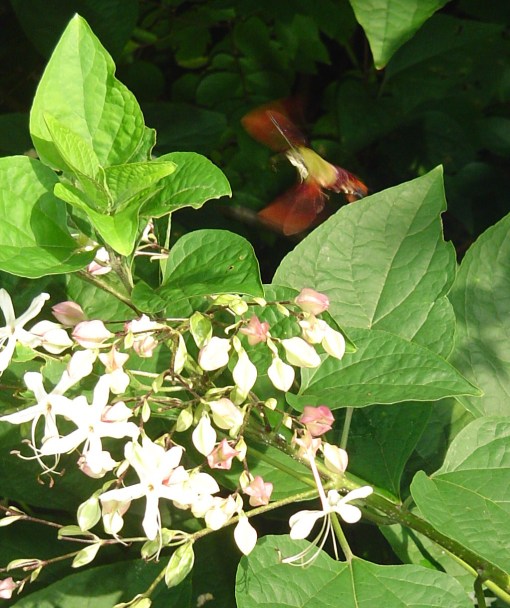
Hummingbird Clearwing Moth, Hemaris thysbe. Notice the curled proboscis which is used to suck nectar from the flower.
Have you seen a hummingbird moth this summer?

This hummingbird moth is enjoying nectar from the flowers of Clerodendrum trichotomum, or Butterfly Tree. This beautiful tree is covered in butterflies during its period of bloom from July through September each year.
Hummingbird moths dart around from flower to flower exactly like a hummingbird does. When their movement catches your eye, you think for a moment that you have spotted a tiny hummingbird. When you look more closely, you notice that the tiny creature hovering over a nectar rich blossom and darting from plant to plant actually has clear wings.
This is a good clue that you are observing a moth, not a bird. Although their profile is similar, the moth is a true insect and has antennae.
Hummingbird moths also have a furry covering on their back, much like a bumblebee. If they stay still long enough for you to see their eyes, you’ll notice the compound eyes of an insect.
If you’ve ever tried to observe a hummingbird, you know they are very shy. Although you can eventually begin to work with a hummingbird who visits a feeder, hummingbirds usually fly away when they sense a human presence. Hummingbird moths don’t seem to mind having you close by.
They go about their hungry business of visiting flowers without paying much attention to the camera, or the person behind it.
Hawk moths and sphinx moths are members of the Sphingidae family of moths. These are the fastest flying of all insects. They have the peculiar ability to hover in flight as they feed. Hummingbird moths, all of which belong to the genus Hemaris, are considered to be hawk moths. Since hummingbird moths all have clear wings, they are sometimes called, “clear wing moths”.

The largest caterpillar I’ve ever seen is munching my Osmanthus goshiki shrub. It has been identified by Bostjan Dvorak as Manduca rustica.
The tobacco hornworm caterpillar and tomato hornworm caterpillar will eventually leave their chrysalises as the Carolina sphinx moth, and the five spotted hawk moth, respectively. Both are able to hover over blossoms as they sip nectar. Their bodies and wings are mostly brown.
Many of these beautiful members of the Sphingidae family are found in Virginia gardens. This Hemaris thysbe is the second species of Hemaris I’ve observed in my garden this summer. I’ve seen them in gardens all over the state. They especially love perennial gardens full of phlox, butterfly bushes, lilac, and hibiscus.
Like all moths and butterflies, Hummingbird moths begin life as an egg laid on a leaf. The egg hatches into a caterpillar, who eats leaves for several weeks before forming a chrysalis. When you find caterpillars on plants in the garden, please remember the beautiful creatures they will soon become.

Tomato hornworm caterpillar, who has cleaned the leaves off of this jalapeno pepper plant. Soon he will be a beautiful sphinx moth.
Although they damage the host plant they’re munching, most plants will soon recover with new growth. The caterpillar transforms into its beautiful adult form while in the chrysalis, and when it comes out, is ready to fly off in search of nectar.
To bring these creatures into your garden, plant the nectar rich flowers they love. For a list of plants to include in a butterfly garden, click here. Avoid using insecticides which will poison them. Avoiding pesticides and herbicides allows wildlife to live in your garden in peace and safety. Provide areas of trees and dense shrubs where they can rest and lay their eggs. Your reward will be their presence in your garden for many years to come.
All photos by Woodland Gnome 2013
Find more on Hummingbird Moths here:
- Tiny Hummers and Bumblebirds (roadsendnaturalist.wordpress.com)
- Hummingbird Moth (carolynmalone.wordpress.com)
- Hummingbird Moths (frted.wordpress.com)









Are Hummingbird Moths the same as Hawkmoths? I see that they are. I just posted about Brugmansia and Datura Flowers and apparently the Hawkmoths are the ones that are able to reach into these flowers. I found out about your blog through Eliza Water’s blog. Great blog!
Thank you very much for the kind words, and thank you for visiting Forest Garden today. I’ve just ordered several Brugmansia for this year’s garden. I’ll watch for the Hummingbird Moths to visit them when they bloom. I grew Datura two summers ago, but didn’t notice the visitors. Good to know more plants which will attract them. Best wishes, WG
Great spots! Btw. the first hawkmoth caterpillar is that of a Manduca rustica.
Thank you again for the information. I just re-worked the page and added your identification to the caption. WG
I see hummingbird moths in my garden on the buddleia. The first time I saw one I thought it was a hummingbird.
They move so much like a Hummingbird, it is hard to tell until you get very close. Aren’t they fun to watch?
I just added more photos to today’s post. Thank you for “liking” it 😉
Pingback: Look More Closely… | Forest Garden
Pingback: “Miss Huff” Perennial Lantana | Forest Garden
Appreciate this post. Let me try it out.
I have not seen a hummingbird moth this summer but I have seen them in the past. Nice post. Annie
Thank you, Annie. I hope you do get to see one in your garden this summer. I wasn’t even looking for one yesterday morning but this one caught my eye. He was good enough to let me take photos of him for a good 10 minutes or so. What a treat!
WG